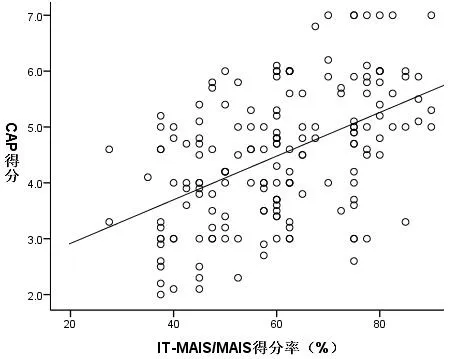175例语前聋患儿人工耳蜗植入术后听觉言语康复效果的评估
2017-02-20郭丽娟叶放蕾王乐李红敏郑州大学第一附属医院耳鼻咽喉头颈外科学河南郑州450052
郭丽娟 叶放蕾 王乐 李红敏(郑州大学第一附属医院 耳鼻咽喉头颈外科学 河南 郑州 450052)
175例语前聋患儿人工耳蜗植入术后听觉言语康复效果的评估
郭丽娟 叶放蕾 王乐 李红敏
(郑州大学第一附属医院 耳鼻咽喉头颈外科学 河南 郑州 450052)
目的 评估语前聋患儿人工耳蜗植入术后的听觉言语康复效果。方法 收集2009-2013年于郑州市康园听力言语康复中心康复的175例语前聋患儿的详细资料,根据人工耳蜗植入时的年龄将研究对象分为两组(3岁及以下组和3岁以上组),应用婴幼儿听觉整合量表(IT-MAIS/MAIS)、听觉行为分级(CAP)及言语可懂度分级(SIR)对两组患儿听觉言语能力进行评估,评估分别在人工耳蜗植入术后的1、3、6、12个月进行。结果 在人工耳蜗植入术后1、3、6、12个月,两组总体康复效果均逐步提高(P均<0.01);3岁及以下组提高较3岁以上组快。IT-MAIS/MAIS与CAP分级之间存在显著正相关性。结论 随着康复时间的延长,语前聋患儿听觉言语康复效果呈逐步上升趋势。康复时间和植入时年龄是影响语前聋患儿人工耳蜗植入术后听觉言语康复效果的重要因素。
人工耳蜗植入;康复效果;听觉行为分级;言语可懂度分级;有意义听觉整合量表
人工耳蜗植入是通过外科手术的方法植入电极装置,它主要针对极重度听力损失和佩戴助听器效果不佳的听障患者[1]。人工耳蜗植入为听力重建提供了先决条件,研究人工耳蜗植入术后听觉言语康复的规律,对于术后康复的开展及效果的评价有着重要的意义。目前,对于语前聋患儿人工耳蜗植入术后听觉言语康复效果的研究较多[2-4],但文献报道并不一致[5-6]。因此,本文回顾性分析175例语前聋患儿人工耳蜗植入术后听觉言语康复资料,评估其听觉言语康复的效果。
1 资料与方法
1.1 一般资料 以2009-2013年于河南省康园听觉言语康复中心进行听觉言语康复的175名语前聋患儿为研究对象,所有研究对象的纳入及手术成功标准均符合《人工耳蜗植入工作指南(2003年,长沙)》[7],且均以普通话为母语。其中男110例,女65例,3岁及以下组85例,3岁以上组90例,实际年龄为25~106个月,平均(51.1±23.3)个月,植入年龄为12~94个月,平均(37.9±18.5)个月。部分患者术前佩戴助听器,有不同程度的听觉言语能力。所有患儿均在术后1个月左右开机并适时调机。
1.2 评估方法
1.2.1 婴幼儿有意义听觉整合量表/有意义听觉整合量表(infant-toddle meaningful auditory integration scale/meaningful auditory integration scale,IT-MAIS/MAIS) IT-MAIS/MAIS包括10个问题,共分为3个方面。根据每个问题出现的频率,有0、1、2、3、4共5个分级。IT-MAIS和MAIS主要是前两个问题不同。IT-MAIS第1、2题主要评估婴幼儿的自主发音情况,MAIS第1、2题考察婴幼儿对人工耳蜗的依赖程度,IT-MAIS和MAIS的第3~6题主要了解婴幼儿察觉声音的能力,第7~10题主要评价婴幼儿识别声音的能力。开机年龄在36个月以内的应用IT-MAIS量表进行评估,开机年龄超过36个月的应用MAIS量表进行评估。所有评分均通过对儿童家长进行当面调查或电话随访得出。最后以得分率作为统计量,得分率=(实际得分/理论总分)×100%。如果超过2项没有得分,则不纳入统计范围。
1.2.2 听觉行为分级(categories of auditory performance,CAP)和言语可懂度分级(speech intelligibility rating,SIR) CAP和SIR均由诺丁汉大学Nikolopoulos等[8]提出,CAP将患儿的听觉能力分为0~9级,由家长根据患儿对外界声音的反应进行评估;SIR则根据儿童自发言语可被理解的程度将其分为1~5级,同样由家长进行评估。

2 结果
2.1 术后IT-MAIS/MAIS随康复时间变化的趋势 两组语前聋患儿人工耳蜗植入术后IT-MAIS/MAIS得分率均随康复时间延长而提高,但两组增长的速率不同,3岁以下组提高的速率较快(P<0.01),两组IT-MAIS/MAIS得分率在康复时间的第3、6个月增长较快,差异有统计学意义(P<0.01)。见图1。

图1 两组患儿术后IT-MAIS/MAIS随康复时间变化的趋势
2.2 术后CAP及SIR随康复时间的变化情况 随着康复时间的延长,对于CAP及SIR,3岁及以下组和3岁以上组评估结果均逐步增加,各康复时间点间差异有统计学意义(P<0.05)。两组6、12个月CAP评分结果差异有统计学意义(P<0.05);两组12个月SIR评分结果差异有统计学意义(P<0.05)。见表1。

表1 CAP及SIR各组评分随康复时间的变化情况分)
2.3 术后IT-MAIS/MAIS得分率与CAP得分的相关性分析 IT-MAIS/MAIS与CAP得分具有显著的正相关性(r=0.492,P<0.01)。见图2。

图2 语前聋患儿IT-MAIS/MAIS得分率与CAP得分变化趋势及其相关性
3 讨论
人工耳蜗植入是目前治疗重度、极重度感音神经性聋的有效方法。但是,如何有效合理地评价人工耳蜗植入术后的听觉康复效果仍是一个难题。目前,IT-MAIS/MAIS、CAP及SIR对人工耳蜗植入术后听觉言语康复效果评价的有用性已经得到证实[9-11],这3种评估方法均采用问卷的形式,不受患儿配合度的影响,较易进行。
听觉规律的发展优先于人工耳蜗的植入,人工耳蜗植入时年龄越小,听觉发展曲线越陡峭,术后听觉康复效果增长速度越快,反之则听觉曲线平缓,听觉康复效果增长较慢[12]。Schramm等[13]指出,早发现、早植入人工耳蜗有利于极重度感音神经性聋患儿获得较好的听觉言语康复效果。本研究结果显示,IT-MAIS/MAIS得分率随着康复时间的延长呈现增高趋势,康复的前6个月提升较后6个月快,3岁及以下组提升较3岁以上组快。这与Senkal等[14]报道一致,考虑原因可能为听觉中枢发育具有一定的“敏感期”,越早行人工耳蜗植入,可以越早地暴露于语言环境下,刺激语言中枢发育,故听觉发展越快,康复效果越明显。
Fang等[15]应用CAP和SIR量表对84例语前聋人工耳蜗植入患儿进行为期5 a的跟踪监测,发现3岁以前植入的患儿CAP得分更高,CAP得分在康复3 a时达到平台期,而SIR在康复的5 a时达到平台期。本研究结果显示,两组患儿的CAP和SIR得分随康复时间的延长逐步增长,3岁及以内患儿CAP和SIR得分增长速度较3岁以上组快,且SIR得分增长较CAP得分滞后。考虑原因为语前聋患儿开机时的听力水平相当于新生儿,需要从察觉声音开始,逐步发展到识别、理解声音并进行沟通,SIR得分多侧重于沟通方面,故较CAP得分增长滞后。因本研究随诊时间为1 a,CAP得分及SIR得分尚未达到明显的平台期,故不能推测出CAP得分及SIR得分在听觉言语康复中平台期出现的时间。
有研究显示,CAP和SIR评估与多数评估方法具有相关性[16]。本研究结果显示,IT-MAIS/MAIS得分率与CAP得分之间存在显著正相关性(r=0.492,P<0.01),说明两者对康复效果的评估具有较好的一致性,在对康复效果的解释方面具有相对的同等性,但也可以看出相同的IT-MAIS/MAIS得分率,CAP得分之间存在较大差异,两者皆是由父母根据患儿在日常环境中对声音的反应做出的评估,都具有一定的主观性。IT-MAIS/MAIS着眼于对声音的察觉、识别和理解,而CAP着眼于对声音的察觉、识别和沟通,故两量表不能相互等同,在行听觉言语评估时应注意两者之间的不同点。
综上,本研究应用多个量表,从康复时间、植入年龄方面对语前聋患儿听觉言语康复进行了评价,但语前聋人工耳蜗患儿术后康复训练是一个复杂且需要长期坚持的过程,应从多方面进行长期的随访观察,以得到更加符合听觉发展规律的结论。
[1] Ozdemir S,Tuncer U,Tarkan O,et al. Factors contributing to limited or non-use in the cochlear implant systems in children:11 years experience[J].Int J Pediatr Otorhinolaryngol,2013,77(3):407-409.
[2] Geers A E,Nicholas J G,Sedey A L.Language skills of children with early cochlear implantation[J].Ear Hear,2003,24(1 Suppl):46S-58S.[3] Waltzman S B,Robbins A M,Green J E,et al.Second oral language capabilities in children with cochlear implants[J].Otol Neurotol,2003,24(5):757-763.
[4] Dunn C C,Walker E A,Oleson J,et al.Longitudinal speech perception and language performance in pediatric cochlear implant users:the effect of age at implantation[J].Ear Hear,2014,35(2):148-160.
[5] Tavora-Vieira D,Marino R,Acharya A,et al.The impact of cochlear implantation on speech understanding,subjective hearing performance,and tinnitus perception in patients with unilateral severe to profound hearing loss[J].Otol Neurotol,2015,36(3):430-436.
[6] Umat C,Siti H K,Azlizawati A R.Auditory functionality and early use of speech in a group of pediatric cochlear implant users[J].Med J Malaysia,2010,65(1):7-13.
[7] 中华医学会耳鼻咽喉科学分会,中华医学会耳鼻咽喉科杂志编辑委员会.人工耳蜗植入工作指南(2003年,长沙)[J].中华耳鼻咽喉科杂志,2004,(2):5-8.
[8] Nikolopoulos T P,Archbold S M,Gregory S.Young deaf children with hearing aids or cochlear implants:early assessment package for monitoring progress[J].Int J Pediatr Otorhinolaryngol,2005,69(2):175-186.[9] Kubo T,Iwaki T,Sasaki T.Auditory perception and speech production skills of children with cochlear implant assessed by means of questionnaire batteries[J].ORL J Otorhinolaryngol Relat Spec,2008,70(4):224-228.
[10]Bosco E,D’Agosta L,Mancini P,et al.Speech perception results in children implanted with Clarion devices:Hi-Resolution and Standard Resolution modes[J].Acta Otolaryngol,2005,125(2):148-158.
[11]Yang Y,Liu Y H,Fu M F,et al.Home-based early intervention on auditory and speech development in mandarin-speaking deaf infants and toddlers with chronological aged 7-24 months[J].Chin Med J (Engl),2015,128(16):2202-2207.
[12]Zheng Y,Soli S D,Tao Y,et al.Early prelingual auditory development and speech perception at 1-year follow-up in Mandarin-speaking children after cochlear implantation[J].Int J Pediatr Otorhinolaryngol,2011,75(11):1418-1426.
[13]Schramm B,Bohnert A,Keilmann A.Auditory,speech and language development in young children with cochlear implants compared with children with normal hearing.Int J Pediatr Otorhinolaryngol[J].2010,74(7):812-819.
[14]Senkal O A,Hizal E,Yavuz H,et al.Short-term results of Neurelec Digisonic SP cochlear implantation in prelingually deafened children[J].Eur Arch Otorhinolaryngol,2014,271(6):1415-1422.
[15]Fang H Y,Ko H C,Wang N M,et al.Auditory performance and speech intelligibility of Mandarin-speaking children implanted before age 5[J].Int J Pediatr Otorhinolaryngol,2014,78(5):799-803.[16]Moon I J,Kim E Y,Chu H,et al.A new measurement tool for speech development based on Ling’s stages of speech acquisition in pediatric cochlear implant recipients[J].Int J Pediatr Otorhinolaryngol,2011,75(4):495-499.
The evaluation of auditory and speech abilities of 175 prelingually deaf children after cochlear implantation
Guo Lijuan,Ye Fanglei,Wang Le,Li Hongmin
(DepartmentofOtolaryngology,theFirstAffiliatedHospitalofZhengzhouUniversity,Zhengzhou450052,China)
Objective To evaluate the auditory and speech abilities of prelingually deaf children after cochlear implantation. Methods 175 prelingually deaf children treated in Kangyuan Auditory and Speech Rehabilitation Center of Zhengzhou from 2009 to 2013 were included in this study. According to the age at implantation, the children were divided into 2 groups based on if their ages were older than 3 years or not. The questionnaires of IT-MAIS/MAIS, CAP and SIR were used to evaluate the auditory and speech abilities. The evaluation was presented 1, 3, 6 and 12 months after cochlear implantation. Results The rehabilitation effects of two groups were gradually improved after cochlear implantation (P<0.01). The performance of auditory and speech rehabilitation in implantees who were younger than 3 years old elevated more promptly than the other group. There was a remarkable positive correlation between IT-MAIS/MAIS and CAP. Conclusion The auditory and speech abilities of prelingually deaf children have a gradually rising trend with the extension of rehabilitation time. Duration of rehabilitation and age at implantation are the two important factors affecting postoperational rehabilitation effects.
cochlear implantation;rehabilitation effects;categories of auditory performance;speech intelligibility rating;meaningful auditory integration scale
叶放蕾,E-mail:yefanglei000@sina.com。
R 764.9
10.3969/j.issn.1004-437X.2017.01.004
2016-01-23)
